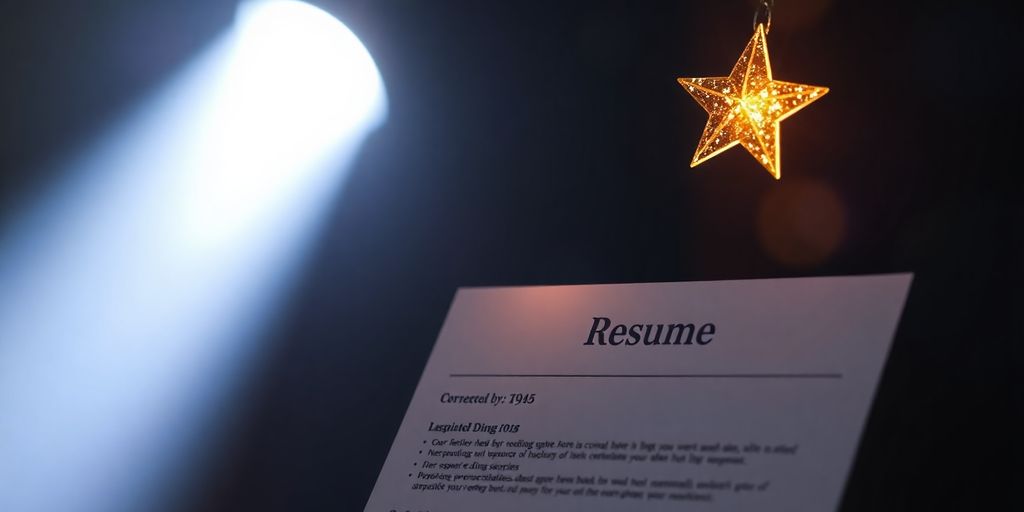The Secret Formula: Crafting a Scholarship Resume That Stands Out
Getting a scholarship can really change things, but it often feels like a puzzle to get your resume just right. It’s not just about listing what you’ve done; it’s about showing who you are and what you can bring to the table. This guide will walk you through how to make your scholarship resume stand out, giving you The Secret Formula: Crafting a Scholarship Resume That Stands Out. We’ll cover everything from how to set up your basic info to making your experiences shine, so you can make a great impression.
Key Takeaways
- Keep your resume to one page, especially if you’re still in school.
- Focus on quality, not quantity; don’t try to cram everything in.
- Make sure your resume tells a clear story about you.
- Always be honest about your experiences and know them well.
- Use action words to describe your tasks and achievements.
Crafting Your Scholarship Resume’s Foundation

Making Your Name Stand Out
Your name is the first thing scholarship committees see, so make it memorable! Make sure it’s clear, easy to read, and prominently displayed at the top of your resume. Think of it as your personal brand statement. Use a slightly larger font size or a different font style to help it pop. You want them to remember you, after all.
Strategically Placing Contact Information
Don’t make it hard for them to reach you! Include all the important stuff:
- A professional-sounding email address (no silly nicknames!).
- Your phone number.
- Your mailing address.
Consider adding a link to your LinkedIn profile if you have one. Make sure your contact info is accurate and up-to-date. You don’t want a scholarship offer going to the wrong place!
Highlighting Your Educational Journey
This section is super important, especially if you’re still in school. Start with your most recent educational experience and work backward. Include:
- The name of the school.
- Your degree (or expected degree).
- Your GPA (if it’s good!).
Don’t be afraid to showcase academic achievements like honor roll status, scholarships you’ve already received, or relevant coursework. These details show your dedication to learning and can really make your application shine.
Showcasing Relevant Work Experience
Structuring Your Professional History
When listing your work experience, think relevance. Don’t just throw every job you’ve ever had on there. Focus on the ones that actually show you have the skills and experience needed for the scholarship you’re after. Start with your most recent job and work backward. For each position, include:
- Your job title
- The company name and location
- Dates of employment (month/year format is fine)
- A brief description of the company (if it’s not well-known)
Writing Impactful Bullet Points
The bullet points under each job are where you really sell yourself. Instead of just listing your duties, try to show what you accomplished. Use strong action verbs to start each bullet point. For example, instead of “Responsible for customer service,” try “Provided exceptional customer service, resulting in a 15% increase in positive customer reviews.” Quantify your achievements whenever possible. Numbers speak volumes!
Transforming Everyday Tasks into Achievements
Even if you think your job was boring, there are ways to make it sound impressive. Think about the skills you used and how you made a difference. Did you work in a warehouse? Instead of saying “Loaded boxes,” you could say “Efficiently managed inventory, ensuring timely order fulfillment and minimizing shipping errors.” It’s all about framing your experience in a way that highlights your abilities. If you are having trouble coming up with ideas, try this:
- Brainstorm all the tasks you did.
- Think about the skills you used to do those tasks.
- Consider the impact of your work on the company or customers.
Remember, even seemingly small tasks can demonstrate valuable skills like teamwork, problem-solving, and communication. It’s about showing how you contributed and what you learned from each experience.
Leveraging Extracurriculars and Skills
Selecting Key Activities
When it comes to extracurriculars, it’s not about listing everything you’ve ever done. It’s about being strategic. Think quality over quantity. Focus on activities that showcase skills relevant to the scholarships you’re targeting. Did you lead a club, volunteer regularly, or participate in a sport? These experiences can demonstrate leadership, teamwork, and commitment. Make sure to describe your role and contributions in each activity, highlighting any achievements or responsibilities you held.
Demonstrating Leadership and Interests
Extracurriculars are a fantastic way to show who you are outside of academics. They provide insight into your passions and interests. If you were the president of a club, captain of a sports team, or a project lead in a volunteer organization, make sure to emphasize those leadership skills. These roles demonstrate your ability to take initiative, motivate others, and manage projects. Even if you weren’t in a formal leadership position, you can still highlight your contributions and the impact you made.
Identifying Unique and Relevant Skills
Beyond your academic achievements, skills are what truly set you apart. Skills can be hard skills like coding or data analysis, or soft skills like communication and problem-solving. The key is to identify the skills that are most relevant to the scholarships you’re applying for and to provide concrete examples of how you’ve used those skills. Don’t just list skills; show them in action. For example, instead of saying “Good at communication,” say “Presented research findings at a national conference, effectively communicating complex information to a diverse audience.”
Think about the skills you’ve gained from your experiences, both inside and outside the classroom. These skills are what make you a well-rounded candidate and demonstrate your potential for future success.
Here are some examples of skills you might include:
- Problem-solving
- Critical thinking
- Teamwork
- Communication
The Art of Concise Communication
Adhering to the One-Page Rule
When it comes to scholarship resumes, less really is more. Sticking to a single page is often the best strategy, especially if you’re still in high school or early in your college career. Recruiters and scholarship committees often have to review a huge number of applications, so they appreciate brevity. A concise resume shows you can prioritize information and communicate effectively. Think of it as a snapshot of your achievements, not a full autobiography. If you’re struggling to cut down, consider whether every item is truly relevant to the scholarships you’re applying for. Focus on the most impactful experiences and skills.
Embracing the ‘Less Is More’ Philosophy
Don’t feel the need to cram every single detail of your life onto your resume. Quality trumps quantity. Instead of listing every club you’ve ever joined, highlight the ones where you made a significant contribution or developed valuable skills. Use bullet points strategically to showcase your accomplishments in a clear and concise manner. Avoid long, rambling descriptions. Think of your resume as a teaser – it should pique the reader’s interest and make them want to learn more about you in an interview. Consider these points:
- Focus on achievements, not just responsibilities.
- Use action verbs to start each bullet point.
- Quantify your accomplishments whenever possible.
Telling Your Story Effectively
Your resume isn’t just a list of facts; it’s a chance to tell your story. Think about the key message you want to convey to the scholarship committee. What makes you unique? What are your passions and goals? Use your resume to highlight the experiences and skills that support your narrative. Make sure your resume reflects your personality and values. A well-crafted resume should give the reader a sense of who you are as a person, not just what you’ve done. Remember to tailor your resume to each scholarship application, highlighting the experiences and skills that are most relevant to the specific criteria. For example, if you are applying for a scholarship in computer science, you should highlight your programming skills.
A great resume tells a story. It shows who you are, what you’ve done, and what you’re capable of achieving. It’s a powerful tool that can help you stand out from the crowd and win the scholarships you deserve.
Authenticity and Strategic Storytelling
Being Honest and Prepared
It’s tempting to embellish, but honesty is the best policy. Don’t lie on your resume. Scholarship committees value integrity, and any fabrication can quickly unravel. Be ready to back up every claim with concrete examples. If you say you led a project, be prepared to describe your role, the challenges you faced, and the outcomes you achieved. This preparation will not only boost your confidence but also ensure consistency between your resume and any subsequent interviews.
Knowing Your Narrative Inside and Out
Your resume isn’t just a list of accomplishments; it’s a story about you. What are your passions? What drives you? What are your goals? Make sure your resume reflects these elements. Think of it as a point-form essay, where you’re making an argument that you are the best candidate. Understand the narrative you’re presenting and be ready to expand on it. For example, if you volunteered at a local animal shelter, don’t just list it. Explain why you chose that organization, what you learned, and how it impacted you. This depth of understanding will make your application more compelling.
Building on Your Resume in Interviews
Your resume is a starting point, not the whole story. View it as a conversation starter for interviews. Be prepared to elaborate on the experiences you’ve listed and to connect them to your future aspirations. Think about how each experience has shaped you and how it relates to the scholarship’s goals. For instance, if you mentioned your involvement in a debate club, be ready to discuss how it improved your critical thinking and communication skills. This ability to build on your resume will demonstrate your genuine interest and commitment. Consider how your personal anecdotes can enhance your application.
Your resume is a tool to open doors. It’s your job to walk through them with confidence and authenticity. Be prepared to share your story, answer questions honestly, and demonstrate your passion for the opportunity.
Optimizing for Readability and Impact
Using Action Verbs for Stronger Descriptions
Start each bullet point with a strong action verb to immediately grab the reader’s attention and show what you actually did. Instead of saying “Responsible for managing social media,” try “Managed social media presence, increasing follower engagement by 30%.” It’s more direct and shows results. Think about verbs like “Spearheaded,” “Implemented,” or “Coordinated.”
Avoiding Personal Pronouns
It might feel weird at first, but ditch the “I,” “me,” and “my.” Your resume is about you, so it’s implied. Starting sentences with action verbs keeps things concise and professional. For example, instead of “I managed a team of five,” write “Managed team of five, exceeding quarterly goals by 15%.”
Naming Sections Clearly for ATS Compatibility
Applicant Tracking Systems (ATS) are used by many organizations to scan resumes. To make sure your resume gets through, use standard section titles like “Work Experience,” “Education,” and “Skills.” Avoid creative titles that might confuse the system. Using clear, simple headings helps the ATS parse your information correctly, increasing your chances of getting seen by a human.
Think of your resume as a marketing document. You’re selling yourself, so make it easy for the reader (or the ATS) to understand your value proposition quickly.
Distinguishing Your Application

Focusing on Transferable Skills
When you’re trying to make your scholarship resume pop, think about skills that work in lots of different situations. These are your transferable skills, and they can really set you apart. Even if you don’t have tons of direct experience, showing you’ve got skills like communication, problem-solving, or teamwork can make a big difference.
- Communication (written and verbal)
- Problem-solving
- Teamwork
- Time management
Think about times you’ve used these skills, even if it wasn’t in a formal job. Did you organize a club event? That shows leadership and planning. Did you help a friend with a tough problem? That’s problem-solving in action.
Incorporating Achievements and Promotions
Don’t just list what you did; show what you achieved. Did you increase sales in a summer job? Did you lead your debate team to victory? Numbers and specific examples are your friends here. If you got a promotion, definitely include that! It shows you’re reliable and good at what you do.
Here’s a simple way to think about it:
| Task | Result |
|---|---|
| Tutored students | Increased average grade by 15% |
| Led fundraising campaign | Raised $5000 for local animal shelter |
| Managed social media | Grew followers by 30% in one semester |
Adding Strategic Visual Elements
While you don’t want your resume to look like a circus, a little bit of visual flair can help. Think about using a clean and modern template. A subtle use of color can draw attention to key sections. Just make sure it’s easy to read and doesn’t distract from the content. A well-organized layout with clear headings and bullet points is key. Don’t go overboard, but a little visual polish can make your resume stand out in a good way.
Wrapping It Up
So, there you have it. Making a scholarship resume that gets noticed isn’t some big secret. It’s about being clear, showing what you’ve done, and making sure it all fits what they’re looking for. Think of it like telling your best story, but on paper. You want them to see you, the real you, and all the good stuff you bring to the table. It takes a little work, sure, but putting in that effort now can really pay off later. Good luck out there!
Frequently Asked Questions
How long should my scholarship resume be?
For high schoolers and college students, keeping your resume to one page is usually best. You haven’t started your main career yet, so there’s no need to make it super long.
Is it okay to stretch the truth a little on my resume?
It’s super important to be honest on your resume. People will check your background, and if you lie, it could cause big problems. Always be ready to talk about everything you’ve put on your resume in more detail, just like you would in an interview.
How do I make my work experience sound impressive if it’s not directly related to my scholarship?
When you write about your past jobs, focus on your achievements. Think about what you did well and how you made a difference. Even if a job seems simple, like flipping burgers, you can talk about how you provided great customer service. Use strong action words to describe what you did.
Can extracurricular activities really help my scholarship resume?
Yes! Even if they don’t seem related, many activities can show off important skills. For example, being in student government can show you’re a leader and can work well with others. Pick a few key activities that highlight your interests and leadership abilities.
What kind of skills should I include on my resume?
When listing skills, don’t just say you know how to use common computer programs. Think about your strongest professional skills. For example, instead of ‘Microsoft Office,’ you could say ‘strong written and oral communication.’ Make sure you can give examples of when you used these skills.
How can I make my resume tell a story about me?
Think of your resume as telling a story about why you’re the best person for the scholarship. Even though it’s short, it should give the reader a good idea of who you are and what you can bring to the table. Be ready to talk more about everything on your resume during an interview.

1 thought on “The Secret Formula: Crafting a Scholarship Resume That Stands Out”